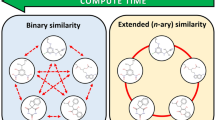Anew method for assessing the structural similarity of pharmacologically active substances based on a hierarchical description of the chemical structure by QL-language descriptors with varying degrees of complexity was developed. The proposed QL-similarity coefficient was shown to enable recognition of structurally similar compounds. An in silico search for Maillard reaction inhibitors among new adamantane derivatives was carried out by the method of similarity to standards using the IT Microcosm software complex. Two compounds with greater activity than the reference compound (aminoguanidine) and seven compounds with comparable activity were found in in vitro experiments.

Similar content being viewed by others
References
G. Maggiora, M. Vogt, D. Stumpfe, et al., J. Med. Chem., 57(8), 3186 – 3204 (2014).
P. M. Dean (ed.), Molecular Similarity in Drug Design, Springer-Science + Business Media B. V., Dordrecht, Netherlands (2012).
H. Kubinyi, Perspect. Drug Discovery Des., 9(11), 225 – 252 (1998).
N. A. Ansari and Z. Rashid, Biomed. Khim., 56(2), 168 – 178 (2010).
G. Grunberger, Eur. J. Clin. Pharmacol., 70(11), 1277 – 1289 (2014).
P. M. Vasil’ev and A. A. Spasov, Ross. Khim. Zh. (Zh. Ross. Khim. O’va im. D. I. Mendeleeva), 50(2), 108 – 127 (2006).
P. M. Vassiliev, A. A. Spasov, V. A. Kosolapov, et al., in: Application of Computational Technique in Pharmacy and Medicine, Challenges and Advances in Computational Chemistry and Physics, Vol. 17, Springer Science + Business Media, Dordrecht, Netherlands (2014), pp. 369 – 431.
State Registration Certificate for a Computer Program, No. 2011618547 (Russia) (2011).
State Registration Certificate for a Database, No. 2015620157 (Russia) (2015).
A. Jedsadayanmata, Naresuan Univ. J., 13(2), 35 – 41 (2005).
A. Zielesny, J. Chem. Inf. Model., 45(5), 1474 – 1477 (2005).
ChemAxon (Hungary) (2018); https://www.chemaxon.com/.
E. A. Shokova, M. Tasula, Yu. N. Luzikovi, et al., Zh. Org. Khim., 35(6), 869 – 881 (1999).
G. M. Butov, V. V. Burmistrov, D. V. Danilovi, et al., Izv. Akad. Nauk, Ser. Khim., 7, 1569 – 1576 (2015).
V. Burmistrov, C. Morisseau, K. S. S. Lee, et al., Bioorg. Med. Chem. Lett., 24(9), 2193 – 2197 (2014).
G. M. Butov, V. V. Burmistrov, Yu. A. Popov, et al., Izv. VolgGTU, Ser. Khim. Tekhnol. Elementoorg. Monomerov Polim. Mater., No. 14, Izd. VolgGTU, Volgograd (2015), No. 4 (159), pp. 14 – 18.
Acknowledgments
The studies were performed at VolgSMU under a Russian Science Foundation Grant (Project No. 14-25-00139).
Author information
Authors and Affiliations
Corresponding author
Additional information
Translated from Khimiko-Farmatsevticheskii Zhurnal, Vol. 54, No. 10, pp. 37 – 41, October, 2020.
Rights and permissions
About this article
Cite this article
Vasil’ev, P.M., Kochetkov, A.N., Yanalieva, L.R. et al. Hierarchical Assessment of the Structural Similarity of Pharmacologically Active Compounds. Pharm Chem J 54, 1019–1023 (2021). https://doi.org/10.1007/s11094-021-02314-2
Received:
Published:
Issue Date:
DOI: https://doi.org/10.1007/s11094-021-02314-2




